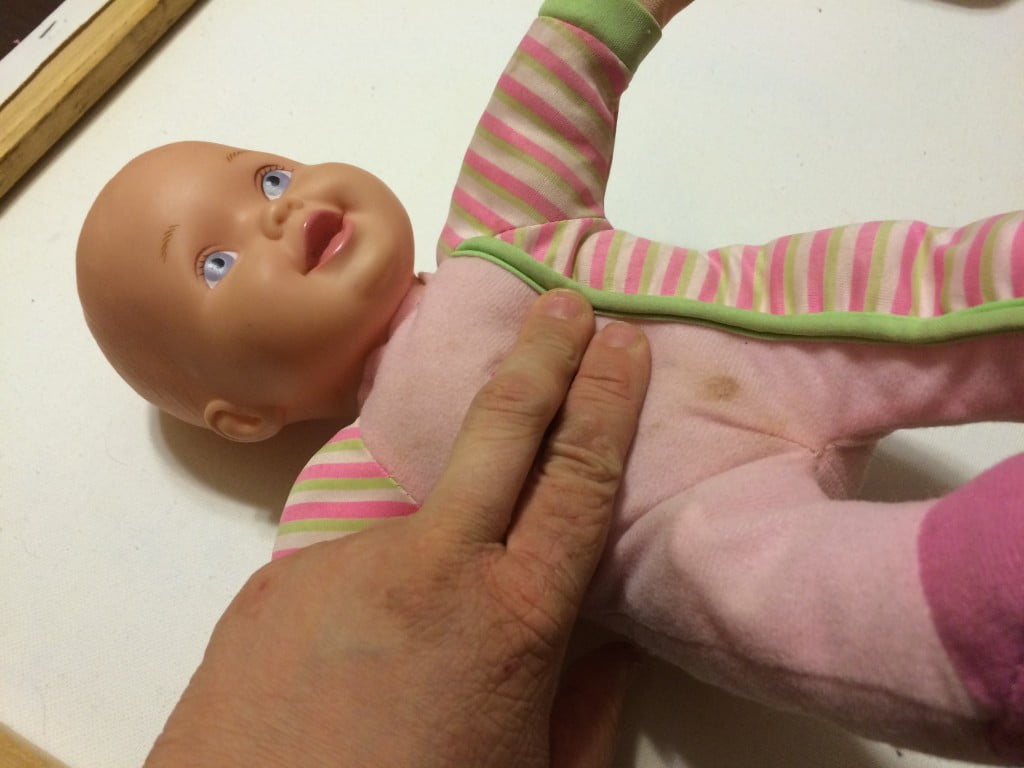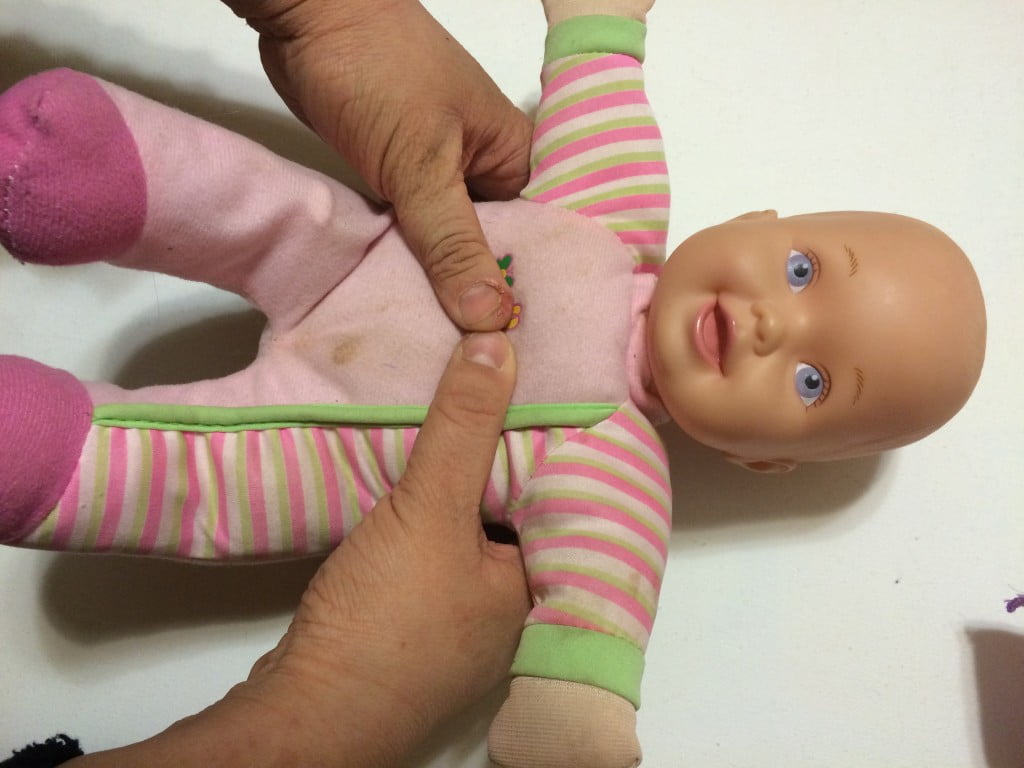The Case:
A previously healthy two month old male is brought in with no vital signs after a large aspiration. Paramedics began CPR immediately after arriving on scene ten minutes ago, but so far have not been able to get a pulse. They will arrive at the hospital shortly and the resuscitation room is ready. Boring? Far from it! But then the staff physician turns to you and asks, “What is the evidence for two thumb verses two finger chest compressions in infants?” Ok, now that’s a little more boring.
The Clinical Question:
Which chest compression technique, two thumb or two finger, is the most effective for infant resuscitation with multiple rescuers in an ER setting?
Background:
There are two techniques of pediatric chest compression that are described in the literature and there has been some debate over which is superior:
A) Two finger technique
The sternum is compressed with two fingers(2nd and 3rd digits or 3rd and 4th digits) using only one hand.

B) Two thumb technique
Both hands are wrapped around the chest of the infant and the thumbs are used for sternal compression.

Some descriptions also endorse concurrently using the fingers to apply a circumferential squeeze.
Search Strategy:
Using Pubmed and Google Scholar, two separate searches were performed: • “pediatric resuscitation” and “chest compression technique” • “two finger” and “two thumb” and “chest compression”
The evidence:
In 2010 a study [1] by Christman et al compared the two techniques. It found greater depth and less variability during sixty seconds of uninterrupted compressions using the two thumb technique (27.2±5.7 vs 22.1±4.6 mm; p=0.0008 and 6.7%±3.2% vs 9.0%±2.8%; p<0.005). A study [2] by Peska et al. in 2006 showed similar initial rates of compression between the two techniques, but a faster rate of fatigue with the two finger technique. The compression rate decreased by 6.9 compressions/min with the two finger technique relative to a decrease of only 2.6 compressions/min with two thumb compressions (p = 0.05). In 2012 a study [3] by Saini et al. compared the proportion of correct finger placements in the two techniques on neonates. It demonstrated correct placements only 6.7% of the time with the two finger technique and 77% of the time with the two thumb technique(p<0.001). A study by Menegazzi et al. in 1993 [4] compared the circumfErential squeeze and two finger techniques in infant swine models. The circumferential squeeze technique resulted in higher systolic blood pressure (59.4 versus 41.6 mm Hg), diastolic blood pressure (21.8 versus 18.5 mm Hg), mean arterial pressure (34.2 versus 26.1 mm Hg), and coronary perfusion pressure (15.1 versus 12.2 mm Hg) (all p<0.001). A manikin study conducted by Dorfsman et al. [5] also found the circumferential squeeze technique to provided significantly higher systolic, diastolic, mean arterial, and pulse pressures than the two thumb technique.

A brand new study in the Emergency Medicine Journal confirmed the previous conclusions, finding greater depth of compressions (p<0.001), greater proportion of effective compressions (p<0.001), smaller proportion of complete recoil (p=0.001), and smaller fatigue score change (p=0.003) than the two finger technique [6].
The guidelines:
Considering the above evidence, it is clear that the two hand encircling technique with thumbs on the centre of the thorax is superior. The ILCOR Paediatric basic and advanced life support guideline from 2010 is consistent with this evidence. It states: “The two thumb encircling hands chest compression technique with thoracic squeeze is the preferred technique for two-rescuer infant CPR.”[7] This guideline will be updated in 2015 to incorporate some of the more recent evidence discussed in this post, however, it is likely that their final recommendation will be the same.
The Bottom Line:
The evidence supports the use of the two thumb technique for infant resuscitation as it has been shown to:
- provide greater depth and consistency of compressions,
- be less susceptible to fatigue,
- have a higher percentage of correct hand placements, and
- provide higher end systolic and coronary perfusion pressures.
The added benefit of a circumferential squeeze in the two thumb model has been less well studied, but a pediatric animal model has shown promise that may further improve arterial and coronary perfusion.
References:
- Christman C, Hemway RJ, Wyckoff MH, Perlman JM. The two-thumb is superior to the two-finger method for administering chest compressions in a manikin model of neonatal resuscitation. Arch Dis Child Fetal Neonatal Ed. 2011 ;96(2):F99-F101.
- Peska E, Kelly AM, Kerr D, Green D. One-handed versus two-handed chest compressions in paediatric cardio-pulmonary resuscitation. Resuscitation 2006; 71:65.
- Saini, S. S., Gupta, N., Kumar, P., Bhalla, A. K., & Kaur, H. (2011). A comparison of two-fingers technique and two-thumbs encircling hands technique of chest compression in neonates. Journal of Perinatology, 32(9), 690-694.
- Menegazzi JJ, Auble TE, Nicklas KA, et al. Two-thumb versus two-finger chest compression during CRP in a swine infant model of cardiac arrest. Ann Emerg Med 1993; 22:240.
- Dorfsman ML, Menegazzi JJ, Wadas RJ, Auble TE. Two-thumb vs. two-finger chest compression in an infant model of prolonged cardiopulmonary resuscitation. Acad Emerg Med 2000; 7:1077.
- Jo et al. Over-the-head two-thumb encircling technique as an alternative to the two-finger technique in the in-hospital infant cardiac arrest setting: a randomised crossover simulation study. Emerg Med J 2014 (2014), p. emermed-2014-203873v1
- International Liaison Committee on Resuscitation. Paediatric basic and advanced life support. Resuscitation 2005; 67: 271-291.
Reviewing with the Staff | With Dr. Damian Roland
University / Hospital: Leicester Hospitals and Leicester University Academic Position (if you have one): Honorary Senior Lecturer
Twitter: @damian_roland
Its been a persistent challenge in paediatric resuscitation to work out what really works so it is pleasing to see some practical advice come forward that is evidence based and may help save a life. What is more, the recently produced ILCOR review completely corroborates the findings from this summary. Therefore the challenge now is not to debate and cogitate about potential exceptions and petty statistical inferences but to get on and make sure everyone involved in the acute care of children is aware of these conclusions. This really is a case where children should not be subject to the 17 year knowledge translation gap!


